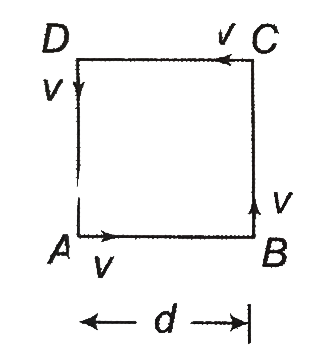Repeat the previous problem if the particle C s displaced through a distance x along the line AB.
To solve the problem step by step, we will analyze the forces acting on the particle C when it is displaced by a distance x along the line AB and derive the expression for the time period of its oscillatory motion.
Step 1: Understand the Setup
We have two fixed charges, A and B, each with charge Q, separated by a distance D. A third charge, C, also with charge Q, is initially placed at the midpoint of AB. When C is displaced by a distance x along the line AB, we need to analyze the forces acting on it.
Hint: Visualize the arrangement of the charges and the displacement of charge C.
Step 2: Determine the New Positions
When charge C is displaced by x:
- The distance from A to C becomes D2+x.
- The distance from B to C becomes D2−x.
Hint: Use the midpoint concept to find the new distances after displacement.
Step 3: Calculate the Forces Acting on Charge C
The forces acting on charge C due to charges A and B can be calculated using Coulomb's law:
- The force FA exerted by charge A on charge C is given by:
FA=kQ2(D2+x)2
- The force FB exerted by charge B on charge C is given by:
FB=kQ2(D2−x)2
Hint: Remember that the forces will act in opposite directions.
Step 4: Find the Net Force on Charge C
The net force Fnet acting on charge C when displaced is:
Fnet=FA−FB=kQ2(D2+x)2−kQ2(D2−x)2
Hint: Set up the equation for net force considering the direction of forces.
Step 5: Simplify the Expression for Net Force
Using the approximation x≪D, we can expand the denominators using the binomial approximation:
(D2+x)−2≈(D2)−2−2(D2)−3x
(D2−x)−2≈(D2)−2+2(D2)−3x
Substituting these into the expression for Fnet and simplifying gives:
Fnet≈−32kQ2D3x
Hint: Use the Taylor expansion for simplification.
Step 6: Relate the Net Force to Simple Harmonic Motion
The net force can be expressed in the form F=−kx, where k is the effective spring constant. From our expression:
k=32kQ2D3
Hint: Recognize that this form indicates simple harmonic motion.
Step 7: Find the Time Period of Oscillation
The time period T of oscillation for a mass m undergoing simple harmonic motion is given by:
T=2π√mk
Substituting our expression for k:
T=2π√mD332kQ2
Hint: Use the formula for the time period of SHM and substitute the effective spring constant.
Final Answer
The time period of the oscillation of charge C when displaced by a distance x is:
T=2π√mD332kQ2
We have two fixed charges, A and B, each with charge Q, separated by a distance D. A third charge, C, also with charge Q, is initially placed at the midpoint of AB. When C is displaced by a distance x along the line AB, we need to analyze the forces acting on it.
When charge C is displaced by x:
- The distance from A to C becomes D2+x.
- The distance from B to C becomes D2−x.
The forces acting on charge C due to charges A and B can be calculated using Coulomb's law:
- The force FA exerted by charge A on charge C is given by:
FA=kQ2(D2+x)2
- The force FB exerted by charge B on charge C is given by:
FB=kQ2(D2−x)2
The net force Fnet acting on charge C when displaced is:
Fnet=FA−FB=kQ2(D2+x)2−kQ2(D2−x)2
Using the approximation x≪D, we can expand the denominators using the binomial approximation:
(D2+x)−2≈(D2)−2−2(D2)−3x
(D2−x)−2≈(D2)−2+2(D2)−3x
Substituting these into the expression for Fnet and simplifying gives:
Fnet≈−32kQ2D3x
The net force can be expressed in the form F=−kx, where k is the effective spring constant. From our expression:
k=32kQ2D3
The time period T of oscillation for a mass m undergoing simple harmonic motion is given by:
T=2π√mk
Substituting our expression for k:
T=2π√mD332kQ2
The time period of the oscillation of charge C when displaced by a distance x is:
T=2π√mD332kQ2
Topper's Solved these Questions
- ELECTRIC FIELD AND POTENTIALBOOK - HC VERMACHAPTER - ELECTRIC FIELD AND POTENTIALEXERCISE - Objective 2
8 Videos
- ELECTRIC CURRENT THROUGH GASESBOOK - HC VERMACHAPTER - ELECTRIC CURRENT THROUGH GASESEXERCISE - Exercises
23 Videos
- ELECTROMAGNETIC INDUCTIONBOOK - HC VERMACHAPTER - ELECTROMAGNETIC INDUCTIONEXERCISE - EXERCISE
9 Videos
Similar Questions
Knowledge Check
In the previous problem, If the string C is stretched slowly, then
AThe portion AB of the string will breakBThe portion BC of the string will breakCNone of the string will breakDNone of the aboveIn the previous problem, the maximum horizontal distance will be
A160√3mB140√3mC120√3mD100√3mIn the previous problem, the distance travelled by boat along the flow is
A50mB100mC150mD200m
In a previous problem if force F applied at a distance x above the centre then find out linear and angular acceleation.
View SolutionIn the previous problem, if the particle occupies a position x=7m at t=1s, then obtain an expression for the instantaneous displacement of the particle.
View SolutionIf in the previous problem, the particle travels 9/25 of the distance in its last second, find the time of fall and the height of the tower.
View SolutionTwo particles A and B , each carrying charge Q are held fixed with a separation D between them. A particle C having mass m and charge q is kept at the middle point of the line AB.
(a) If it is displaced throught a distance x perpendicular to AB, what would be the electric force experienced by it .
(b) Assuming x little, show that this force is proportional to x.
(c) under what conditions will the paricle C execute simple harmonic motion if it is released after such a small displacement? Find the time period of the oscillations if these conditions are stisfied.
View SolutionIn the previous problem , if the shells A and C are at the same potential , then
View Solution


